mobile View, to the German Version tap the flag


- Republic of Mozambique
- presidial republic
- own name: Républica de Moçambique
• Flag
• Historical Flags
• Meaning/Origin of the Flag
• Coat of Arms
• Meaning/Origin of the Coat of Arms
• Aircraft Roundel
• Map
• Numbers and Facts
• History
• Origin of the Country's Name
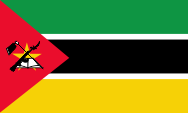
National, state and merchant flag,
ratio = 3:5,
Source, by: Corel Draw 4





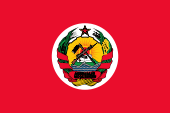
Flag of the President,
ratio = 2:3,
Source, by: Jam123, CC0, via Wikimedia Commons



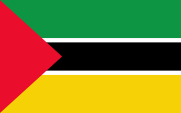
1962–1997,
Flag of the FRELIMO party,
ratio = 5:8,
Source, by: Wikipedia (DE)



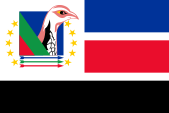
Flag of the RENAMO party,
ratio = 2:3,
Source, by: Jolle, CC BY 3.0,
via Wikimedia Commons, Wikipedia (DE)




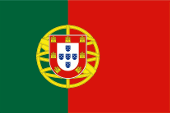
1911–1975,
National flag of Portugal,
ratio = 2:3,
Source: Corel Draw 4





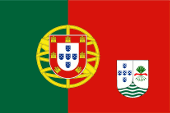
Sixties of the 19th century,
purposed flag for Portugese East Africa,
ratio = 2:3,
Source: Wikipedia (DE)



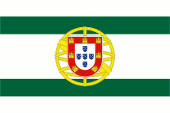
to 1935,
Flag of a High Commissioner,
ratio = 2:3,
Source: Flaggenbuch 1939



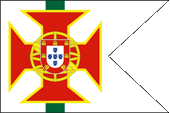
1935–1961,
Flag of a District Commandant,
ratio = 2:3,
Source: Flaggenbuch 1939



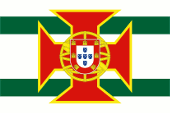
1935–1975,
Flag of the Governor General,
ratio = 2:3,
Source: Die Welt im bunten Flaggenbild



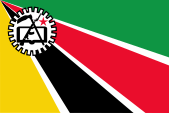
1975–1983,
National flag,
ratio = 2:3,
Source: Flaggen und Wappen




The today's flag of Mozambique was introduced on 1st of May in 1983. It shows three horizontal stripes in green, black and yellow with slender white separating stripes among them. On the leech an isosceles red triangle with a simplified version of the coat of arms of Mozambique in it. That emblem consists of hoe and Kalashnikov-MPi (AK-47), crossing themselves, as well as a opened book. In the background a yellow five-pointed star. The colours of the flag seem to be defined today as follows: green = Pantone 355, red = Pantone 185 and yellow = Pantone 116. The colour green stands for the fertile soil, red for the struggle for freedom, black for the African continent and yellow for the mineral resources of the country. The flag of Mozambique is based on the flag of the FRELIMO-Movement (Frente de Libertaçao de Moçambique). That flag was allowed to hoist already one year before the independence beside the Portugese flag. For the creation of the flag of the FRELIMO was the pattern the flag of the South African ANC. In this way the the FRELIMO flag showed the colours of the ANC green, black and yellow, with them white slender separating stripes and a red triangle on the pole. The for the independent Mozambique on 25th of June in 1975 introduced flag showed indeed as well that colours however in an other arrangement and with a simplified version of the coat of arms. In the year 1983 should momentary – for only one or two days – has been in use an on the model of the flag of the FRELIMO basing flag as national flag. It showed the emblem of the flag of 1975 in front of a large yellow five-pointed star in the red triangle on the leech. In the times of the Portugese colony was solely in use the Portugese national flag because they saw the colonies as permanent component of the motherland and not as outer possessions. This implys that Portugese colonies never had own flags, even if there were ambitions in the sixties of the 20th century to introduce flags for the colonies by placing of the coat of arms of the colony in the flying end of the Portugese national flag. But this plans became never realized. In the year 1935 own coats of arms were created for the Portuguese colonies. The design was subject to a special scheme. So each coat of arms contained, in addition to a local symbolism, the five Quinas from the coat of arms of Portugal and five green waves on silver. As the local symbolism in the coat of arms of Portuguese East Africa a bundle of arrows and a yoke.
Source:
Flags of the World,
World Statesmen,
Volker Preuß

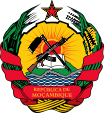
since 1982,
Coat of arms of Mozambique,
Source: Jam123, CC0, via Wikimedia Commons

1935–1975,
Coat of arms of Portuguese East Africa,
Source, by: Wikipedia (D)

The coat of arms of Mozambique exists in the today's form since September 1982 and shows in front of the background of a yellow sprocket (allegory of industrialization) in the lower part of the coat of arms blue wave lines (ocean) and a green map of the country. Thereupon a book (allegory of literacy), the rising sun (allegory of a new start) a how and a Kalashnikov-MPi (AK-47) crossing themselves. They symbolize the farmer's staus and the vigilant readiness for defense of the country. The yellow bordered red star stands for the independence and the political orientation of the state, the socialism. On the red banner in the lower part of the coat of arms the name of the country in Portugese. Details of the coat of arms have been changed several times. In the year 1935 own coats of arms were created for the Portuguese colonies. The design was subject to a special scheme. So each coat of arms contained, in addition to a local symbolism, the five Quinas from the coat of arms of Portugal and five green waves on silver. As the local symbolism in the coat of arms of Portuguese East Africa a bundle of arrows and a yoke.
Source:
Flaggen Wappen Hymnen,
Flaggen und Coat of arms of the Welt,
Wikipedia (D),
Volker Preuß

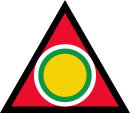
since 2011,
Aircraft Roundel,
Source, by: Wikipedia (EN)
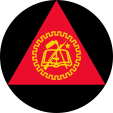
1975–2011,
Aircraft Roundel,
Source, by: Wikipedia (EN)

Location:
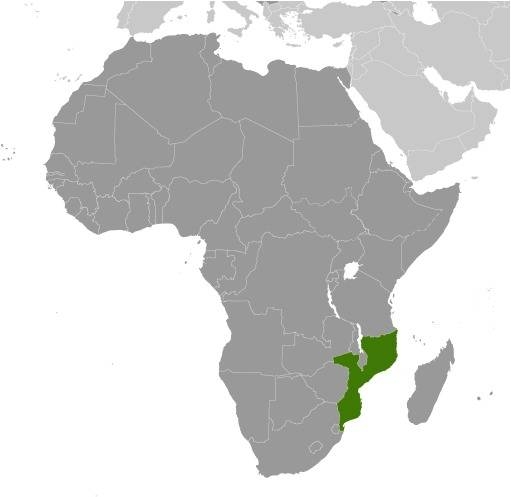
Source: CIA World Factbook
Map of the country:
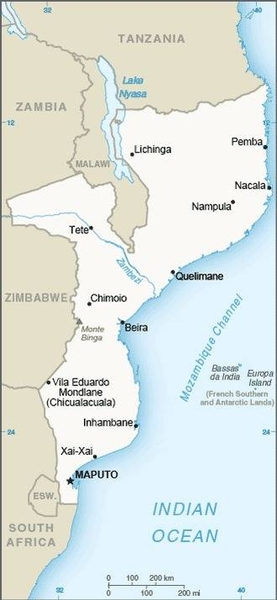
Source: CIA World Factbook

Area: 309.494 square miles
Inhabitants: 32.200.000 (2021), thereof 98% Bantu, 1,5% Asians, 0,4% Portugese
Religions: 28% Roman Catholic, 25% other Christian, 18% Muslim, 12% Protestant, 6% Animist, 18% Non-Religious
Density of Population: 104 inh./sq.mi.
Capital: Maputo (Lourenço Marques), 1.101.170 inh. (2017)
official Language: Portugese
other Languages: Bantu languages, Suaheli
Currency: Metical (MZN, MTn) = 100 Centavos
Time Zone: GMT + 2 h
Source:
Wikipedia (D)

10th/11th cent. · Arabs stablish on the coast the trade stations Quelimane, Sena and Sofala
14th/15th cent. · parts of the today's Mozambique southern the Zambezi River belong to the Empire of Monomotapa (Simbabwe)
1498 · the Portugese seafarer Vasco da Gama discoveres and debarks on the coast of the today's Mozambique
1505–1507 · Portugal conquers the Arab trade stations and nearly the whole east African coast to Mogadishu (Somalia), in the afteryears settle Portugese colonists especially near the Zambezi River and develop the country following the course of the river, the colony becomes administrated from Goa (India)
1544 · Portugal occupies the Delagoa Bay
17th cent. · Portugal is able to expand its area of influence in the south of the country momentary at the territories of the decaying Empire of Monomotapa, in the north Portugal reaches the western bank of the Malawi Sea
1604–1658 · the Netherlands endanger the Portugese possessions
1721–1730 · the Netherlands occupie the Delagoa Bay
1752 · administrative separation from Goa
1869 · border treaty with the Boer State of Transvaal determines the borderline in the south
1875 · foundation of Lourenço Marques in the Delagoa Bay
1880 · Portugal disclaims to favor of Great Britain for parts of its areas of influence (Rhodesia, Malawi)
1885 · the Berlin Congo Conference confirms the Portugese possessions in Portugese East Afrika
1891 · border treaty with Great Britain determines the borderline to Rhodesia and Malawi
1896 · border treaty with the German Empire determines the borderline to German East Africa
1920 · annexation of the Kionga Triangle on the mouth of the Rovuma River (part of German East Africa)
1951 · Portugese East Africa becomes an overseas province of Portugal
1962 · foundation of the FRELIMO liberation movement in Tanganjika
1964 · beginning of the Guerilla fight of the FRELIMO, partial success in the north of the country
25th of June 1975 · independence, proclamation of the People’s Republic of Mozambique, Mozambique becomes a marxistic single-party-state under the FRELIMO-Party
1984 · beginning of the Guerilla fight of the RENAMO, partial success in the north and in the west of the country
1989 · democratization
1990 · new constituion, rename in Republic of Mozambique
1992 · peace agreement between RENAMO and FRELIMO
1994 · elections, victory of the FRELIMO
2000 · riots of RENAMO supporters
2013–2019 · battles between RENAMO and FRELIMO
2019 · peace agreement between RENAMO and FRELIMO
Source:
Atlas zur Geschichte,
World Statesmen,
Discovery '97,
Wikipedia (D)

The name "Mozambique" has its roots in the name of the town "Moçambique" in the north of the country. Maybe that they decided for the name Moçambique as name of the country because this town had in the past a large importance as trade place.
Source: Volker Preuß


![]()





















